Abstract
Intranasal live attenuated cold-adapted (ca) influenza A/Kawasaki/9/86 (H1N1) reassortant virus and parenteral inactivated influenza A/Taiwan/1/86 (H1N1) virus were given alone or in combination to 80 ambulatory elderly subjects. An enzyme-linked immunosorbent assay was used to measure hemagglutinin-specific (HA) antibodies in serum and nasal wash specimens collected before vaccination and 1 and 3 months later. Serum immunoglobulin G (IgG) and nasal wash IgA HA responses were elicited in 56 and 20%, respectively, of 25 inactivated-virus vaccinees and in 67 and 48%, respectively, of 27 recipients of both vaccines but in only 36 and 25%, respectively, of 28 vaccinees given live virus alone. Inactivated virus, administered alone or with live virus vaccine, induced higher titers of serum antibody than did the live virus alone. In contrast, nasal IgA HA antibody was elicited more often and in greater quantity by the vaccine combination than by either vaccine alone. Despite these differences, the peak titers of local antibody mounted by each group of vaccinees were similar. By 3 months postvaccination, serum IgG and nasal IgA HA antibody titers remained elevated above prevaccination levels in 50 and 17%, respectively, of the inactivated-virus vaccinees and in 46 and 23%, respectively, of recipients of both vaccines but in only 19 and 7%, respectively, of the live-virus and systemic antibodies, if vaccinees. The finding that live ca influenza A virus induced short-lived local and systemic antibodies, if confirmed, suggests that live virus vaccination may not be a suitable alternative or adjunct to inactivated virus vaccination for the elderly.
Full text
PDF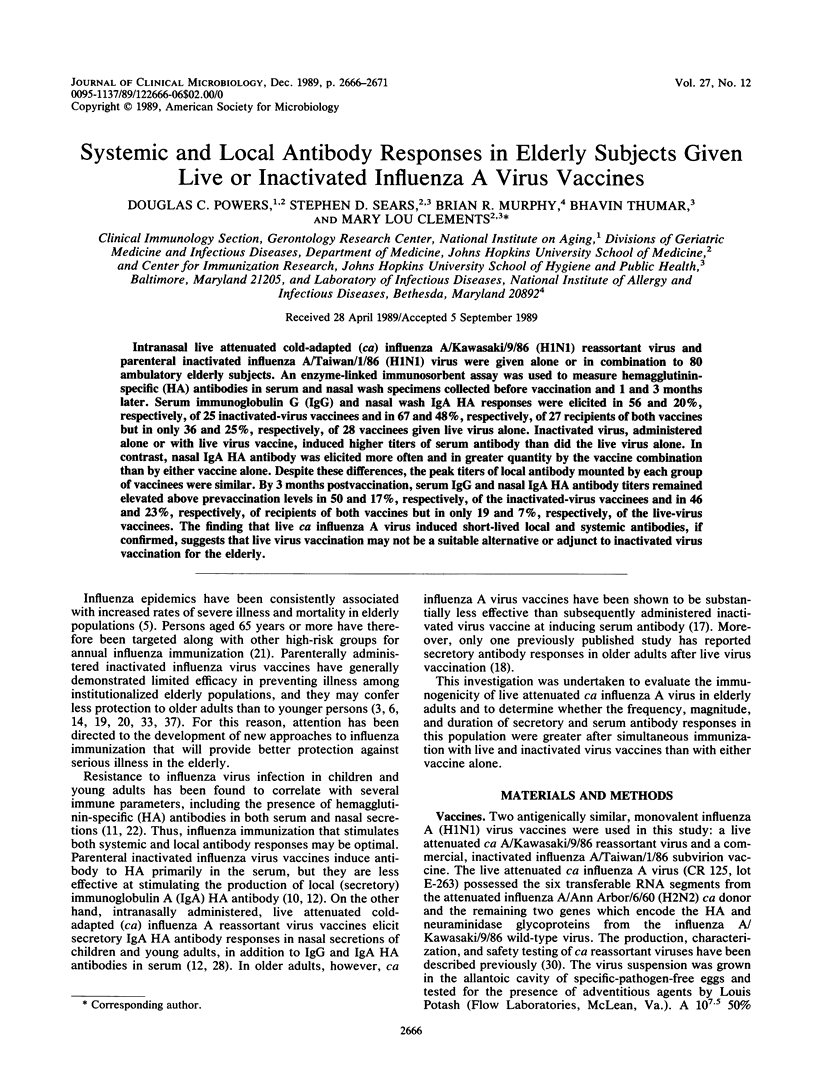
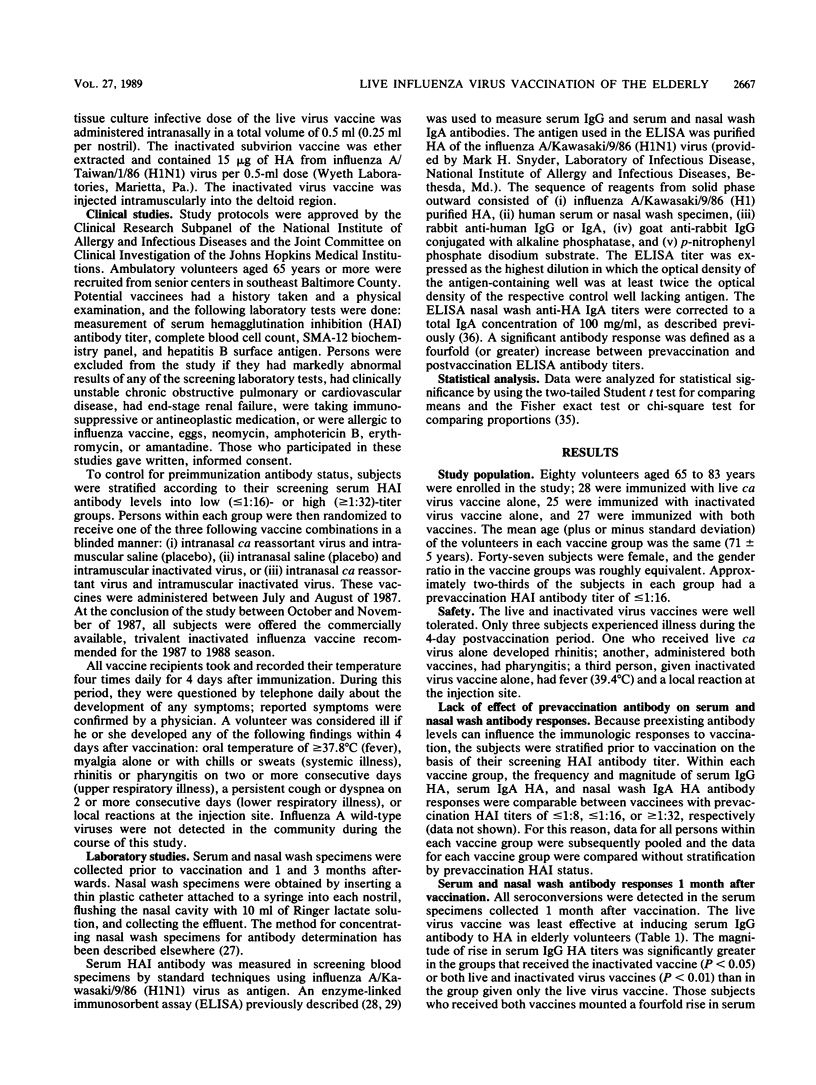
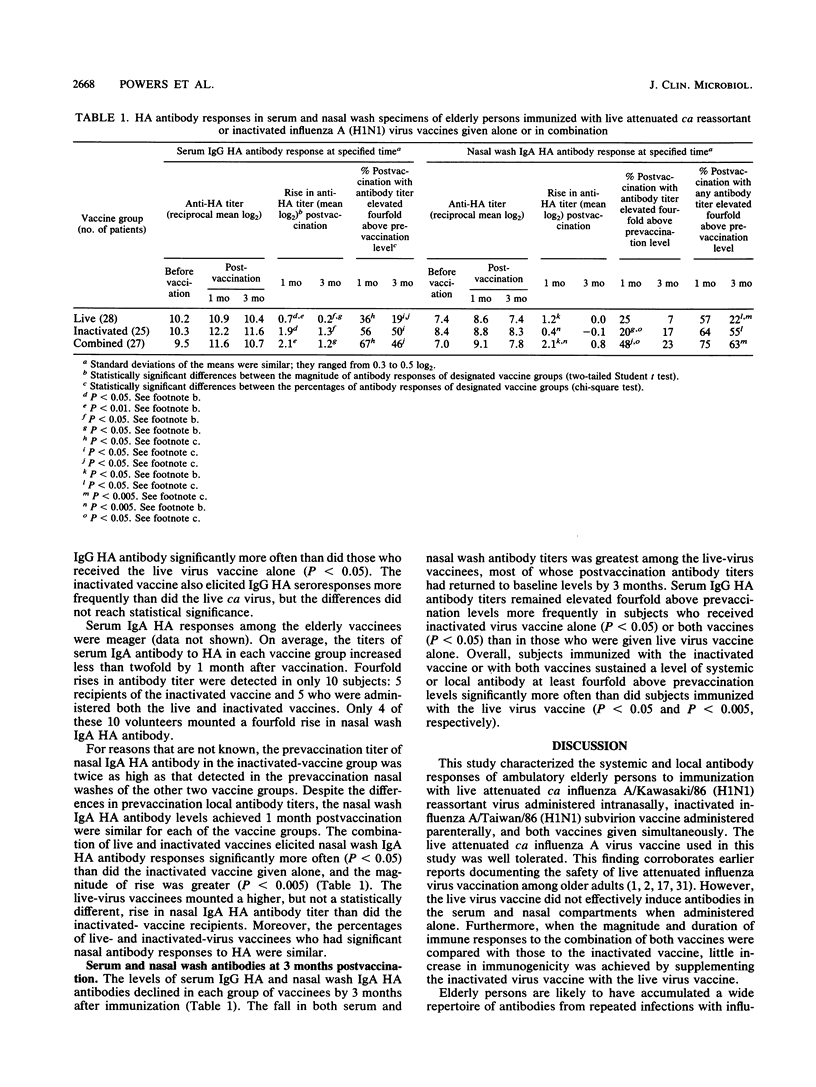
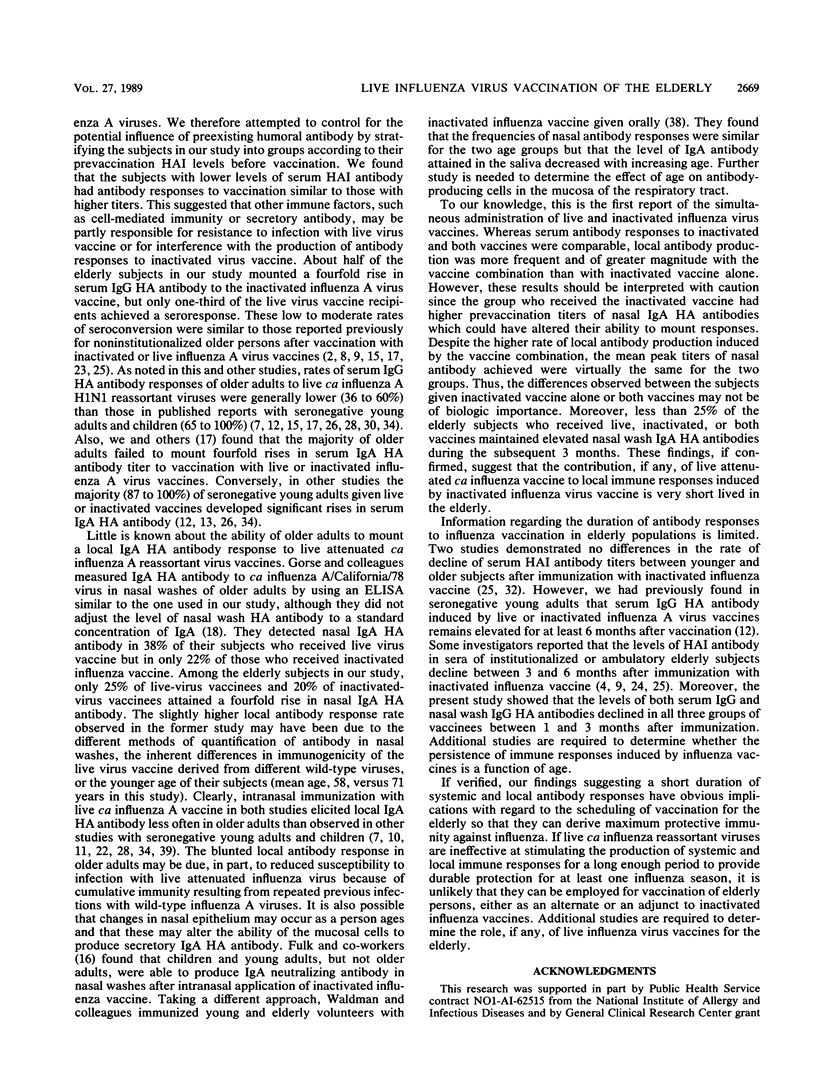
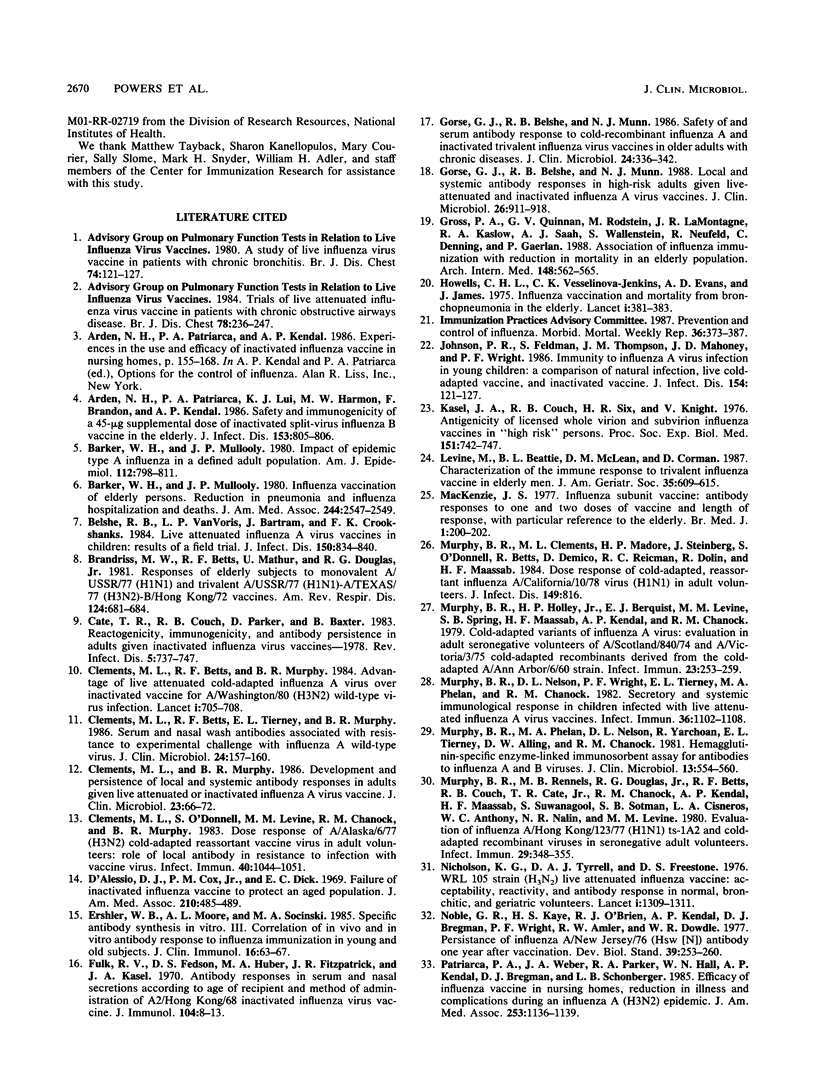
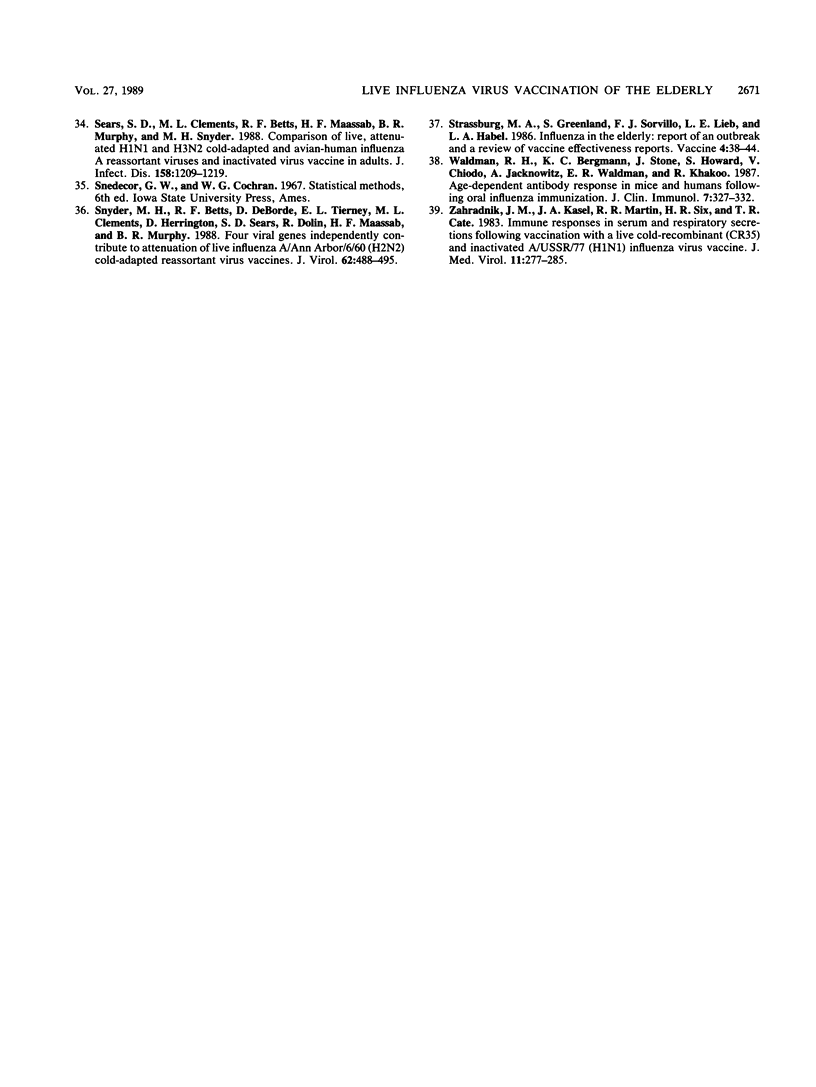
Selected References
These references are in PubMed. This may not be the complete list of references from this article.
- Arden N. H., Patriarca P. A., Lui K. J., Harmon M. W., Brandon F., Kendal A. P. Safety and immunogenicity of a 45-microgram supplemental dose of inactivated split-virus influenza B vaccine in the elderly. J Infect Dis. 1986 Apr;153(4):805–806. doi: 10.1093/infdis/153.4.805. [DOI] [PubMed] [Google Scholar]
- Barker W. H., Mullooly J. P. Impact of epidemic type A influenza in a defined adult population. Am J Epidemiol. 1980 Dec;112(6):798–811. doi: 10.1093/oxfordjournals.aje.a113052. [DOI] [PubMed] [Google Scholar]
- Barker W. H., Mullooly J. P. Influenza vaccination of elderly persons. Reduction in pneumonia and influenza hospitalizations and deaths. JAMA. 1980 Dec 5;244(22):2547–2549. [PubMed] [Google Scholar]
- Belshe R. B., Van Voris L. P., Bartram J., Crookshanks F. K. Live attenuated influenza A virus vaccines in children: results of a field trial. J Infect Dis. 1984 Dec;150(6):834–840. doi: 10.1093/infdis/150.6.834. [DOI] [PubMed] [Google Scholar]
- Brandriss M. W., Betts R. F., Mathur U., Douglas R. G., Jr Responses of elderly subjects to monovalent A/USSR/77 (H1N1) and Trivalent A/USSR/77 (H1N1)-A/TEXAS/77 (H3N2)-B/Hong Kong/72 vaccines. Am Rev Respir Dis. 1981 Dec;124(6):681–684. doi: 10.1164/arrd.1981.124.6.681. [DOI] [PubMed] [Google Scholar]
- Cate T. R., Couch R. B., Parker D., Baxter B. Reactogenicity, immunogenicity, and antibody persistence in adults given inactivated influenza virus vaccines - 1978. Rev Infect Dis. 1983 Jul-Aug;5(4):737–747. doi: 10.1093/clinids/5.4.737. [DOI] [PubMed] [Google Scholar]
- Clements M. L., Betts R. F., Murphy B. R. Advantage of live attenuated cold-adapted influenza A virus over inactivated vaccine for A/Washington/80 (H3N2) wild-type virus infection. Lancet. 1984 Mar 31;1(8379):705–708. doi: 10.1016/s0140-6736(84)92222-0. [DOI] [PubMed] [Google Scholar]
- Clements M. L., Betts R. F., Tierney E. L., Murphy B. R. Serum and nasal wash antibodies associated with resistance to experimental challenge with influenza A wild-type virus. J Clin Microbiol. 1986 Jul;24(1):157–160. doi: 10.1128/jcm.24.1.157-160.1986. [DOI] [PMC free article] [PubMed] [Google Scholar]
- Clements M. L., Murphy B. R. Development and persistence of local and systemic antibody responses in adults given live attenuated or inactivated influenza A virus vaccine. J Clin Microbiol. 1986 Jan;23(1):66–72. doi: 10.1128/jcm.23.1.66-72.1986. [DOI] [PMC free article] [PubMed] [Google Scholar]
- Clements M. L., O'Donnell S., Levine M. M., Chanock R. M., Murphy B. R. Dose response of A/Alaska/6/77 (H3N2) cold-adapted reassortant vaccine virus in adult volunteers: role of local antibody in resistance to infection with vaccine virus. Infect Immun. 1983 Jun;40(3):1044–1051. doi: 10.1128/iai.40.3.1044-1051.1983. [DOI] [PMC free article] [PubMed] [Google Scholar]
- D'Alessio D. J., Cox P. M., Jr, Dick E. C. Failure of inactivated influenza vaccine to protect an aged population. JAMA. 1969 Oct 20;210(3):485–489. [PubMed] [Google Scholar]
- Ershler W. B., Moore A. L., Socinski M. A. Specific antibody synthesis in vitro. III. Correlation of in vivo and in vitro antibody response to influenza immunization in young and old subjects. J Clin Lab Immunol. 1985 Feb;16(2):63–67. [PubMed] [Google Scholar]
- Fulk R. V., Fedson D. S., Huber M. A., Fitzpatrick J. R., Kasel J. A. Antibody responses in serum and nasal secretions according to age of recipient and method of administration of A2-Hong Kong-68 inactivated influenza virus vaccine. J Immunol. 1970 Jan;104(1):8–13. [PubMed] [Google Scholar]
- Gorse G. J., Belshe R. B., Munn N. J. Local and systemic antibody responses in high-risk adults given live-attenuated and inactivated influenza A virus vaccines. J Clin Microbiol. 1988 May;26(5):911–918. doi: 10.1128/jcm.26.5.911-918.1988. [DOI] [PMC free article] [PubMed] [Google Scholar]
- Gorse G. J., Belshe R. B., Munn N. J. Safety of and serum antibody response to cold-recombinant influenza A and inactivated trivalent influenza virus vaccines in older adults with chronic diseases. J Clin Microbiol. 1986 Sep;24(3):336–342. doi: 10.1128/jcm.24.3.336-342.1986. [DOI] [PMC free article] [PubMed] [Google Scholar]
- Gross P. A., Quinnan G. V., Rodstein M., LaMontagne J. R., Kaslow R. A., Saah A. J., Wallenstein S., Neufeld R., Denning C., Gaerlan P. Association of influenza immunization with reduction in mortality in an elderly population. A prospective study. Arch Intern Med. 1988 Mar;148(3):562–565. [PubMed] [Google Scholar]
- Howells C. H., Vesselinova-Jenkins C. K., Evans A. D., James J. Influenza vaccination and mortality from bronchopneumonia in the elderly. Lancet. 1975 Feb 15;1(7903):381–383. doi: 10.1016/s0140-6736(75)91291-x. [DOI] [PubMed] [Google Scholar]
- Johnson P. R., Feldman S., Thompson J. M., Mahoney J. D., Wright P. F. Immunity to influenza A virus infection in young children: a comparison of natural infection, live cold-adapted vaccine, and inactivated vaccine. J Infect Dis. 1986 Jul;154(1):121–127. doi: 10.1093/infdis/154.1.121. [DOI] [PubMed] [Google Scholar]
- Kasel J. A., Couch R. B., Six H. R., Knight V. Antigenicity of licensed whole virion and subvirion influenza vaccines in "high risk" persons. Proc Soc Exp Biol Med. 1976 Apr;151(4):742–747. doi: 10.3181/00379727-151-39298. [DOI] [PubMed] [Google Scholar]
- Levine M., Beattie B. L., McLean D. M., Corman D. Characterization of the immune response to trivalent influenza vaccine in elderly men. J Am Geriatr Soc. 1987 Jul;35(7):609–615. doi: 10.1111/j.1532-5415.1987.tb04335.x. [DOI] [PubMed] [Google Scholar]
- MacKenzie J. S. Influenza subunit vaccine: antibody responses to one and two doses of vaccine and length of response, with particular reference to the elderly. Br Med J. 1977 Jan 22;1(6055):200–202. doi: 10.1136/bmj.1.6055.200. [DOI] [PMC free article] [PubMed] [Google Scholar]
- Murphy B. R., Clements M. L., Madore H. P., Steinberg J., O'Donnell S., Betts R., Demico D., Reichman R. C., Dolin R., Maassab H. F. Dose response of cold-adapted, reassortant influenza A/California/10/78 virus (H1N1) in adult volunteers. J Infect Dis. 1984 May;149(5):816–816. doi: 10.1093/infdis/149.5.816. [DOI] [PubMed] [Google Scholar]
- Murphy B. R., Holley H. P., Jr, Berquist E. J., Levine M. M., Spring S. B., Maassab H. F., Kendal A. P., Chanock R. M. Cold-adapted variants of influenza A virus: evaluation in adult seronegative volunteers of A/Scotland/840/74 and A/Victoria/3/75 cold-adapted recombinants derived from the cold-adapted A/Ann Arbor/6/60 strain. Infect Immun. 1979 Feb;23(2):253–259. doi: 10.1128/iai.23.2.253-259.1979. [DOI] [PMC free article] [PubMed] [Google Scholar]
- Murphy B. R., Nelson D. L., Wright P. F., Tierney E. L., Phelan M. A., Chanock R. M. Secretory and systemic immunological response in children infected with live attenuated influenza A virus vaccines. Infect Immun. 1982 Jun;36(3):1102–1108. doi: 10.1128/iai.36.3.1102-1108.1982. [DOI] [PMC free article] [PubMed] [Google Scholar]
- Murphy B. R., Phelan M. A., Nelson D. L., Yarchoan R., Tierney E. L., Alling D. W., Chanock R. M. Hemagglutinin-specific enzyme-linked immunosorbent assay for antibodies to influenza A and B viruses. J Clin Microbiol. 1981 Mar;13(3):554–560. doi: 10.1128/jcm.13.3.554-560.1981. [DOI] [PMC free article] [PubMed] [Google Scholar]
- Murphy B. R., Rennels M. B., Douglas R. G., Jr, Betts R. F., Couch R. B., Cate T. R., Jr, Chanock R. M., Kendal A. P., Maassab H. F., Suwanagool S. Evaluation of influenza A/Hong Kong/123/77 (H1N1) ts-1A2 and cold-adapted recombinant viruses in seronegative adult volunteers. Infect Immun. 1980 Aug;29(2):348–355. doi: 10.1128/iai.29.2.348-355.1980. [DOI] [PMC free article] [PubMed] [Google Scholar]
- Nicholson K. G., Tyrrell D. A., Freestone D. S. WRL 105 strain (H3N2) live attenuated influenza vaccine: acceptability, reactivity, and antibody response in normal, bronchitic, and geriatric volunteers. Lancet. 1976 Jun 19;1(7973):1309–1311. doi: 10.1016/s0140-6736(76)92648-9. [DOI] [PubMed] [Google Scholar]
- Noble G. R., Kaye H. S., O'Brien R. J., Kendal A. P., Bregman D. J., Wright P. F., Amler R. W., Dowdle W. R. Persistence of influenza A/New Jersey/76 (Hsw1N1) antibody one year after vaccination. Dev Biol Stand. 1977 Jun 1;39:253–260. [PubMed] [Google Scholar]
- Patriarca P. A., Weber J. A., Parker R. A., Hall W. N., Kendal A. P., Bregman D. J., Schonberger L. B. Efficacy of influenza vaccine in nursing homes. Reduction in illness and complications during an influenza A (H3N2) epidemic. JAMA. 1985 Feb 22;253(8):1136–1139. [PubMed] [Google Scholar]
- Sears S. D., Clements M. L., Betts R. F., Maassab H. F., Murphy B. R., Snyder M. H. Comparison of live, attenuated H1N1 and H3N2 cold-adapted and avian-human influenza A reassortant viruses and inactivated virus vaccine in adults. J Infect Dis. 1988 Dec;158(6):1209–1219. doi: 10.1093/infdis/158.6.1209. [DOI] [PubMed] [Google Scholar]
- Snyder M. H., Betts R. F., DeBorde D., Tierney E. L., Clements M. L., Herrington D., Sears S. D., Dolin R., Maassab H. F., Murphy B. R. Four viral genes independently contribute to attenuation of live influenza A/Ann Arbor/6/60 (H2N2) cold-adapted reassortant virus vaccines. J Virol. 1988 Feb;62(2):488–495. doi: 10.1128/jvi.62.2.488-495.1988. [DOI] [PMC free article] [PubMed] [Google Scholar]
- Strassburg M. A., Greenland S., Sorvillo F. J., Lieb L. E., Habel L. A. Influenza in the elderly: report of an outbreak and a review of vaccine effectiveness reports. Vaccine. 1986 Mar;4(1):38–44. doi: 10.1016/s0264-410x(86)80002-0. [DOI] [PubMed] [Google Scholar]
- Waldman R. H., Bergmann K. C., Stone J., Howard S., Chiodo V., Jacknowitz A., Waldman E. R., Khakoo R. Age-dependent antibody response in mice and humans following oral influenza immunization. J Clin Immunol. 1987 Jul;7(4):327–332. doi: 10.1007/BF00915555. [DOI] [PubMed] [Google Scholar]
- Zahradnik J. M., Kasel J. A., Martin R. R., Six H. R., Cate T. R. Immune responses in serum and respiratory secretions following vaccination with a live cold-recombinant (CR35) and inactivated A/USSR/77 (H1N1) influenza virus vaccine. J Med Virol. 1983;11(4):277–285. doi: 10.1002/jmv.1890110403. [DOI] [PubMed] [Google Scholar]


